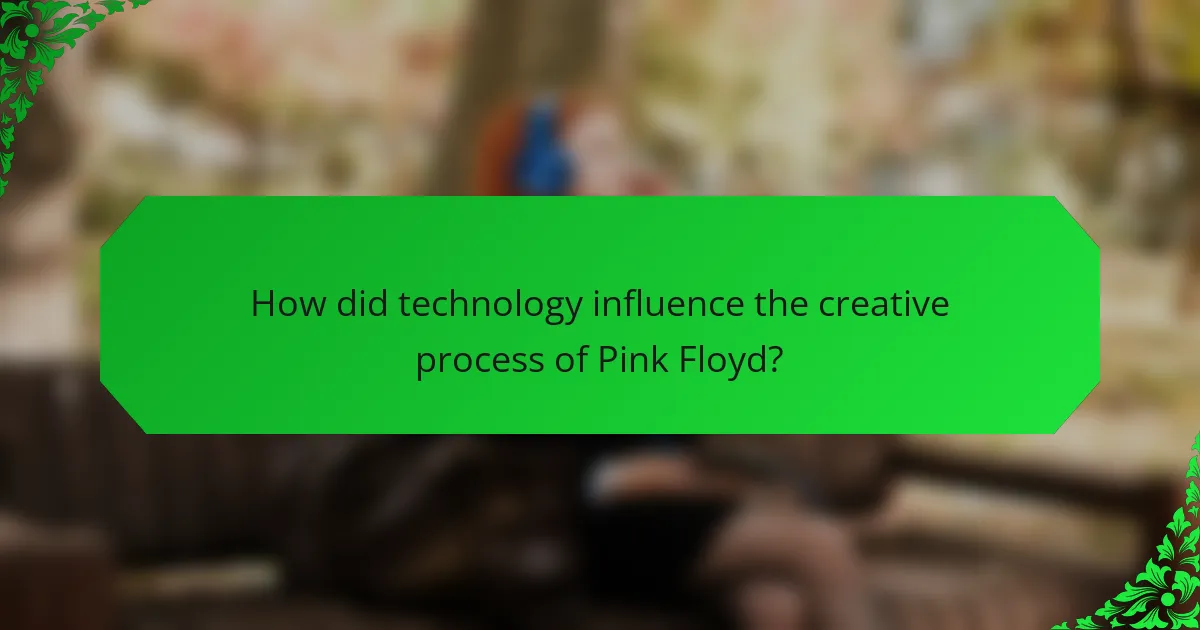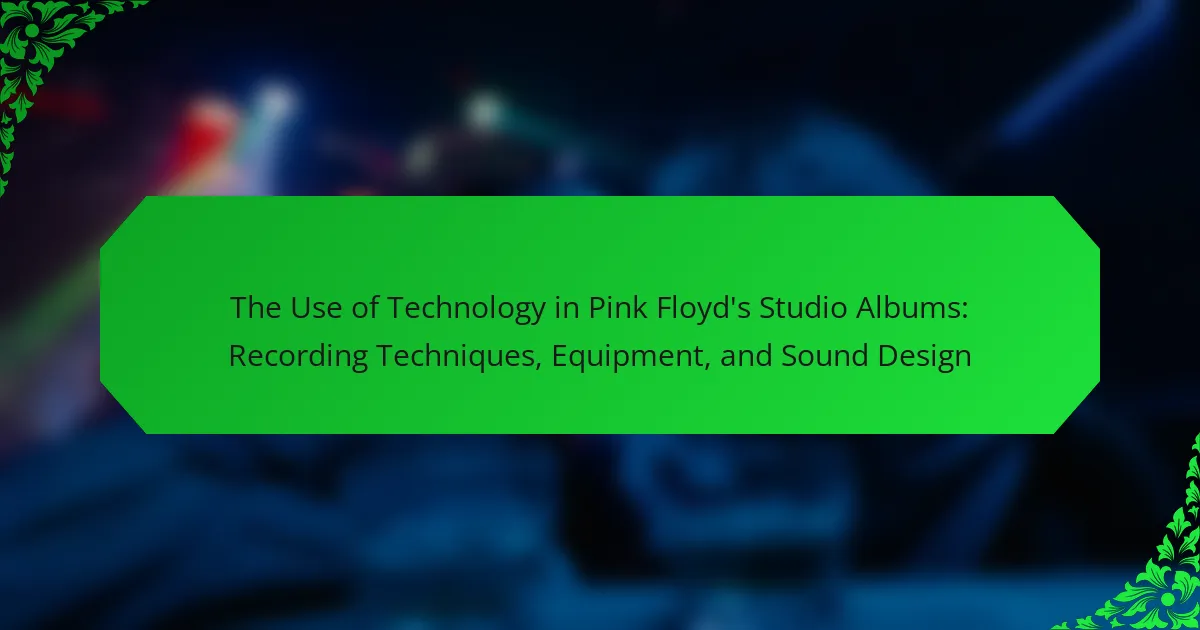The article focuses on the use of technology in Pink Floyd’s studio albums, emphasizing their innovative recording techniques, equipment, and sound design. Pink Floyd utilized advanced methods such as multi-track recording and synthesizers to create intricate soundscapes, particularly evident in their iconic album “The Dark Side of the Moon.” The band also employed tape manipulation techniques and collaborated with engineers to explore new audio technologies, pushing the boundaries of rock music. Their technological advancements not only transformed music production but also set new standards for live performances, leaving a lasting impact on the industry.

What is the role of technology in Pink Floyd’s studio albums?
Technology plays a crucial role in Pink Floyd’s studio albums by enhancing sound experimentation and production quality. The band utilized innovative recording techniques, such as multi-track recording, to layer sounds and create complex arrangements. They employed effects like reverb, delay, and synthesizers to produce unique audio textures. Notably, the use of the EMS Synthi AKS synthesizer on “The Dark Side of the Moon” significantly shaped its sonic landscape. Additionally, advancements in studio equipment allowed for greater manipulation of sound, contributing to the immersive experience of their music. The use of technology enabled Pink Floyd to push creative boundaries and redefine rock music.
How did recording techniques evolve in Pink Floyd’s music?
Recording techniques in Pink Floyd’s music evolved significantly over time. Initially, they utilized conventional studio methods with limited multi-track recording. As they progressed, they embraced advanced technology such as synthesizers and tape manipulation. The album “The Dark Side of the Moon” marked a breakthrough with its use of innovative sound engineering and effects. They incorporated techniques like tape loops and sound collages to create unique auditory experiences. The introduction of digital recording in the 1980s further transformed their approach. Albums like “A Momentary Lapse of Reason” showcased sophisticated digital production techniques. Overall, Pink Floyd’s evolution in recording techniques reflects their commitment to pushing the boundaries of sound.
What specific recording techniques were pioneered by Pink Floyd?
Pink Floyd pioneered several innovative recording techniques. They utilized multi-track recording extensively. This allowed them to layer sounds and create complex compositions. The band also employed tape loops for unique sound effects. They were among the first to experiment with synthesizers in rock music. Their use of quadrophonic sound set a precedent for spatial audio. Additionally, they incorporated field recordings into their albums. These techniques contributed to their distinctive sound and artistic vision.
How did these techniques influence the sound of their albums?
The recording techniques used by Pink Floyd significantly influenced the sound of their albums. Techniques such as multi-track recording allowed for complex layering of instruments and vocals. This resulted in rich, immersive soundscapes that became a hallmark of their music. The use of synthesizers and tape effects expanded their sonic palette. For instance, the incorporation of the EMS Synthi AKS in “The Dark Side of the Moon” added unique textures to the tracks. Additionally, innovative studio techniques like tape looping and sound manipulation contributed to their experimental sound. The use of reverb and delay created atmospheric depth in songs like “Echoes.” Overall, these techniques shaped their distinctive sound and set new standards in music production.
What types of equipment were used in the production of Pink Floyd’s albums?
Pink Floyd utilized various types of equipment in the production of their albums. Key recording equipment included analog tape machines, such as the Studer A80. They employed mixing consoles like the EMI TG12345 for sound manipulation. Effects units, including the Electro-Harmonix Big Muff, shaped their distinctive sound. Synthesizers, notably the Moog Model D, contributed to their sonic landscape. They also used reel-to-reel recorders for multi-track recording. Additionally, microphones from Neumann and Shure captured vocals and instruments. The combination of these tools helped create their innovative sound.
What were the key instruments and devices used in their recording process?
The key instruments and devices used in Pink Floyd’s recording process included synthesizers, guitars, and tape machines. They prominently utilized the EMS Synthi AKS synthesizer for unique sound textures. The Fender Stratocaster guitar played a crucial role in their signature sound. They also employed the Studer A80 tape machine for high-quality recording. The use of the ARP 2600 synthesizer contributed to their innovative soundscapes. Additionally, various effects pedals were used to manipulate guitar sounds. The combination of these instruments and devices defined their sonic identity. Their recording techniques were groundbreaking and influenced many genres.
How did the choice of equipment impact the overall sound design?
The choice of equipment significantly influenced Pink Floyd’s overall sound design. The use of analog synthesizers, such as the EMS Synthi A, allowed for unique sound textures. This equipment facilitated experimentation with sound manipulation and layering. Additionally, the utilization of multi-track recording enabled complex arrangements. The choice of microphones and mixing consoles shaped the clarity and depth of recordings. Effects units, like tape delays and reverb, contributed to the atmospheric quality of their music. Each piece of equipment played a crucial role in creating their signature sound. This deliberate selection of tools directly affected the emotional impact of their albums.
What unique sound design elements are present in Pink Floyd’s music?
Pink Floyd’s music features unique sound design elements such as innovative use of synthesizers, tape effects, and spatial audio techniques. They extensively utilized the EMS Synthi AKS and Moog synthesizers, creating distinctive soundscapes. The band employed tape loops and reverse recordings, adding layers of complexity to their tracks. Additionally, they incorporated field recordings and sound effects, enhancing the immersive experience of their albums. Their use of quadraphonic sound systems allowed for spatial audio, creating a three-dimensional listening experience. The album “The Dark Side of the Moon” exemplifies these techniques with its seamless transitions and sound collages. Overall, these elements contributed to Pink Floyd’s pioneering sound and enduring influence on music.
How did sound effects contribute to the atmosphere of their albums?
Sound effects significantly enhanced the atmosphere of Pink Floyd’s albums. They created immersive soundscapes that complemented the band’s themes. For example, the use of tape loops and reverb added depth to tracks. The incorporation of environmental sounds established a sense of place and emotion. In “The Dark Side of the Moon,” sound effects like cash registers and heartbeat sounds contributed to the album’s exploration of time and mental health. This innovative use of technology helped define the band’s unique sound. Their meticulous attention to detail in sound design set a new standard in music production. Overall, sound effects were essential in crafting the distinct auditory experiences found in their albums.
What role did studio experimentation play in their sound design?
Studio experimentation was crucial in shaping Pink Floyd’s sound design. They utilized innovative recording techniques to create unique auditory experiences. Techniques included tape manipulation, sound layering, and the use of non-traditional instruments. For instance, the band often employed synthesizers and effects pedals to craft distinctive sounds. Their approach allowed for the exploration of new sonic landscapes. The album “The Dark Side of the Moon” exemplifies this, featuring advanced studio technology for its time. Their experimentation led to groundbreaking works that influenced the evolution of rock music. This commitment to innovation solidified their legacy in sound design.

How did technology influence the creative process of Pink Floyd?
Technology significantly influenced the creative process of Pink Floyd by enabling innovative sound experimentation. The band utilized advanced recording techniques and equipment to create their unique soundscapes. They pioneered the use of multitrack recording, allowing for complex layering of instruments and vocals. The incorporation of synthesizers expanded their sonic palette, evident in albums like “The Dark Side of the Moon.”
Furthermore, they employed tape manipulation techniques, such as looping and reversing, to enhance their music’s texture. The use of sound effects and ambient noises contributed to their storytelling approach in songs. Additionally, the band’s collaboration with engineers and producers facilitated the exploration of new audio technologies. This synergy resulted in groundbreaking albums that pushed the boundaries of rock music.
What collaborative techniques did Pink Floyd utilize in the studio?
Pink Floyd utilized several collaborative techniques in the studio. The band members often contributed to songwriting collectively. They engaged in extensive jam sessions to develop musical ideas. Each member brought unique skills, enhancing the creative process. David Gilmour’s guitar work complemented Roger Waters’ lyrical themes. Richard Wright’s keyboard arrangements added depth to their sound. They also experimented with sound effects and studio technology collaboratively. This approach fostered innovation, leading to iconic albums like “The Dark Side of the Moon.” Their collaboration was integral to their artistic success.
How did technology facilitate collaboration among band members?
Technology facilitated collaboration among band members by enabling seamless communication and sharing of ideas. Digital audio workstations allowed members to record and edit tracks independently. This technology helped in composing and arranging music without the need for all members to be present simultaneously. File-sharing platforms made it easy to exchange recordings and feedback. Additionally, virtual instruments and software plugins expanded creative possibilities. The use of multitrack recording enabled intricate layering of sounds. These advancements allowed Pink Floyd to experiment and innovate in their sound design. The result was a more cohesive and collaborative creative process.
What innovative approaches did they take during recording sessions?
Pink Floyd employed several innovative approaches during their recording sessions. They utilized advanced multitrack recording techniques to layer sounds intricately. The band incorporated tape manipulation, including reverse playback and tape loops, to create unique soundscapes. They also experimented with synthesizers and electronic instruments, notably the EMS Synthi AKS, to expand their sonic palette. Additionally, they embraced non-traditional studio environments, such as using a mobile studio for on-location recordings. The use of sound effects and field recordings added depth to their compositions. Their collaborative approach encouraged experimentation and pushed the boundaries of conventional music production. These methods significantly contributed to the distinctive sound of their albums.
How did the use of technology enhance Pink Floyd’s storytelling?
The use of technology significantly enhanced Pink Floyd’s storytelling by allowing for innovative soundscapes and immersive experiences. Advanced recording techniques, such as multi-track recording, enabled the band to layer sounds and create complex arrangements. The use of synthesizers expanded their sonic palette, adding depth to their music. For instance, the ARP Odyssey synthesizer was crucial in creating the iconic sounds in “The Dark Side of the Moon.”
Additionally, the incorporation of sound effects and tape manipulation contributed to narrative elements within their albums. For example, the use of spoken word samples in tracks like “The Great Gig in the Sky” added emotional weight to the storytelling. Their pioneering use of studio technology, such as the EMS Synthi AKS, allowed them to experiment with live performance visuals, enhancing the overall narrative experience.
Overall, technology transformed Pink Floyd’s music into a more profound storytelling medium, making their albums not just collections of songs but cohesive artistic statements.
In what ways did soundscapes contribute to lyrical themes?
Soundscapes significantly enhanced lyrical themes in Pink Floyd’s music. They created immersive environments that complemented the emotional weight of the lyrics. For example, the use of ambient sounds in “The Dark Side of the Moon” deepened themes of mental health and existentialism. Soundscapes often reflected the narrative context, such as the clock ticking in “Time,” which underscored the urgency of life. Additionally, the innovative use of synthesizers added layers of meaning to the lyrics. This combination of sound and lyricism helped convey complex emotions and narratives. The integration of soundscapes allowed for a richer listening experience, making the themes more relatable and impactful.
How did technological advancements allow for richer narratives in their albums?
Technological advancements allowed for richer narratives in Pink Floyd’s albums through enhanced recording techniques and sound design. Innovations such as multitrack recording enabled complex layering of sounds. This allowed the band to create intricate soundscapes that complemented their lyrical themes. The use of synthesizers introduced new textures and atmospheres, enriching the storytelling. Digital editing tools provided precision in sound manipulation, allowing for seamless transitions between musical sections. Techniques like tape looping and sound effects contributed to a more immersive listening experience. The incorporation of surround sound technology further deepened the audience’s engagement. These advancements collectively transformed their albums into cohesive auditory journeys.

What are the lasting impacts of Pink Floyd’s technological innovations?
Pink Floyd’s technological innovations have significantly influenced music production and live performances. Their use of advanced studio techniques, such as multitracking and tape manipulation, set new standards for album production. The band pioneered the use of synthesizers and sound effects, which expanded the sonic possibilities in rock music. Their immersive live shows incorporated cutting-edge audio-visual technology, creating a template for future concerts. The album “The Dark Side of the Moon” utilized innovative recording methods that are still referenced today. This album’s success showcased the potential of high-fidelity sound and conceptual storytelling in music. Pink Floyd’s influence is evident in modern music production, where technology continues to shape artistic expression. Their legacy persists in the ongoing integration of technology in both studio and live settings.
How have Pink Floyd’s recording techniques influenced modern music?
Pink Floyd’s recording techniques have significantly influenced modern music through innovative sound design and production methods. Their use of multi-track recording allowed for complex layering of sounds. This approach enabled musicians to create rich textures in their music. The band pioneered the use of synthesizers and effects, expanding sonic possibilities. Their album “The Dark Side of the Moon” showcased advanced studio techniques, including tape loops and analog effects. This album set a standard for high-quality production in rock music. Additionally, their immersive live performances integrated technology, influencing concert sound design. Many contemporary artists adopt similar techniques to enhance their recordings and live shows.
What contemporary artists cite Pink Floyd as an influence in their use of technology?
Contemporary artists such as Radiohead, The Weeknd, and Tame Impala cite Pink Floyd as an influence in their use of technology. Radiohead incorporates experimental soundscapes and production techniques reminiscent of Pink Floyd’s innovative approach. The Weeknd’s atmospheric production draws from the immersive qualities found in Pink Floyd’s music. Tame Impala utilizes layered instrumentation and effects, echoing the sonic experimentation of Pink Floyd. These artists acknowledge Pink Floyd’s impact on their creative processes and technological advancements in music production.
How have innovations from their albums shaped industry standards?
Innovations from Pink Floyd’s albums have significantly shaped industry standards in music production. Their use of multi-track recording techniques allowed for complex layering of sounds. This approach influenced how future artists approached studio recordings. The incorporation of synthesizers and electronic effects set new benchmarks for sound design. Albums like “The Dark Side of the Moon” showcased the seamless blending of music and narrative, impacting conceptual album formats. The pioneering use of sampling and sound manipulation expanded the creative possibilities for producers. Pink Floyd’s emphasis on high-fidelity sound quality raised expectations for audio engineering in the industry. Their innovative approach to live performances also established standards for concert production and visual integration.
What lessons can be learned from Pink Floyd’s use of technology in music production?
Pink Floyd’s use of technology in music production teaches several key lessons. First, innovation in recording techniques can enhance artistic expression. The band utilized multi-track recording to layer sounds and create complex arrangements. They often experimented with synthesizers, which expanded their sonic palette. Second, embracing technology allows for unique sound design. Pink Floyd’s use of effects like reverb and delay contributed to their atmospheric sound. Third, collaboration with engineers and producers can elevate the quality of music. Their work with Alan Parsons exemplifies this, as he helped refine their sound. Lastly, the integration of narrative and technology can create immersive experiences. Albums like “The Wall” showcase how storytelling can be enhanced through technological means. These lessons highlight the importance of experimentation and collaboration in music production.
What best practices can emerging artists adopt from their approach?
Emerging artists can adopt several best practices from Pink Floyd’s approach to music production. They should prioritize experimentation with sound and technology. Pink Floyd utilized innovative recording techniques to create unique audio experiences. Artists can explore layering sounds and using unconventional instruments. They should embrace collaboration with skilled engineers and producers. This can enhance the creative process and result in richer soundscapes. Additionally, using advanced equipment can help achieve desired sonic qualities. Pink Floyd’s attention to detail in sound design serves as a model for aspiring musicians. By focusing on these practices, emerging artists can elevate their work and establish a distinct artistic identity.
How can technology be effectively integrated into modern music creation?
Technology can be effectively integrated into modern music creation through digital audio workstations (DAWs), software instruments, and advanced recording techniques. DAWs allow musicians to record, edit, and mix music efficiently. Software instruments provide a wide range of sounds and effects, expanding creative possibilities. Advanced recording techniques, such as multi-tracking and automation, enhance production quality. Additionally, collaboration tools enable remote teamwork among artists. The use of plugins and virtual effects can simulate traditional studio equipment. These integrations have revolutionized music production, making it more accessible and versatile for artists.
The main entity of the article is technology in Pink Floyd’s studio albums, specifically focusing on recording techniques, equipment, and sound design. The article examines how technology enhanced sound experimentation and production quality, detailing specific techniques such as multi-track recording, synthesizer use, and innovative sound effects. It highlights the evolution of recording methods throughout the band’s career, the key instruments and devices that shaped their sound, and the impact of these advancements on their storytelling and overall sound design. Additionally, it explores the lasting influence of Pink Floyd’s technological innovations on modern music production and industry standards.
